Alfa Romeo 4C 2015 Owner handbook (in English)
Manufacturer: ALFA ROMEO, Model Year: 2015, Model line: 4C, Model: Alfa Romeo 4C 2015Pages: 199, PDF Size: 7.67 MB
Page 161 of 199
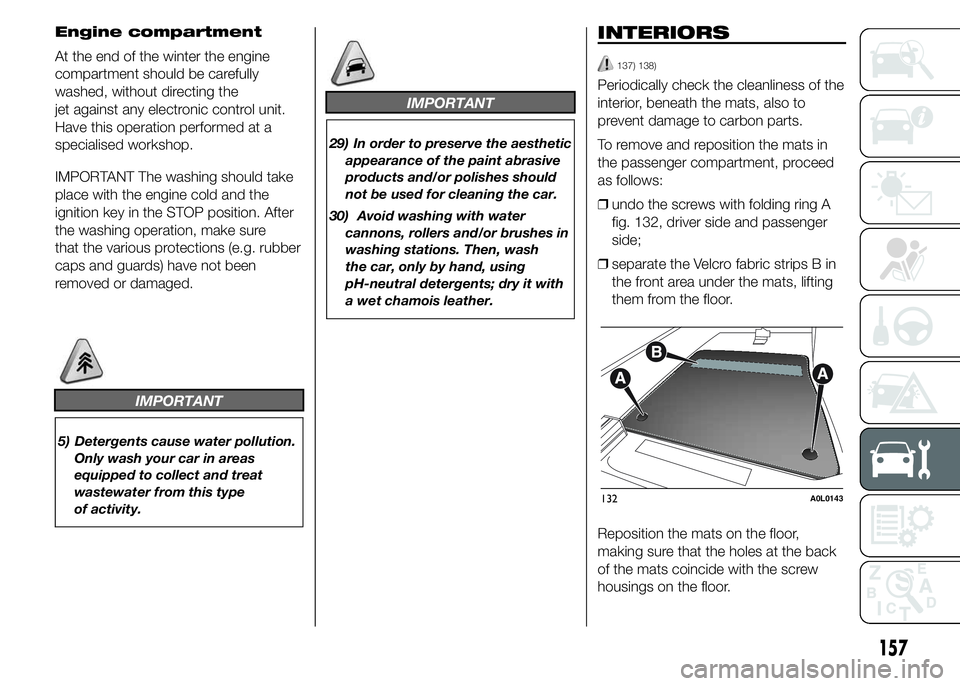
Engine compartment
At the end of the winter the engine
compartment should be carefully
washed, without directing the
jet against any electronic control unit.
Have this operation performed at a
specialised workshop.
IMPORTANT The washing should take
place with the engine cold and the
ignition key in the STOP position. After
the washing operation, make sure
that the various protections (e.g. rubber
caps and guards) have not been
removed or damaged.
IMPORTANT
5) Detergents cause water pollution.
Only wash your car in areas
equipped to collect and treat
wastewater from this type
of activity.
IMPORTANT
29) In order to preserve the aesthetic
appearance of the paint abrasive
products and/or polishes should
not be used for cleaning the car.
30) Avoid washing with water
cannons, rollers and/or brushes in
washing stations. Then, wash
the car, only by hand, using
pH-neutral detergents; dry it with
a wet chamois leather.
INTERIORS
137) 138)
Periodically check the cleanliness of the
interior, beneath the mats, also to
prevent damage to carbon parts.
To remove and reposition the mats in
the passenger compartment, proceed
as follows:
❒undo the screws with folding ring A
fig. 132, driver side and passenger
side;
❒separate the Velcro fabric strips B in
the front area under the mats, lifting
them from the floor.
Reposition the mats on the floor,
making sure that the holes at the back
of the mats coincide with the screw
housings on the floor.
132A0L0143
157
Page 162 of 199
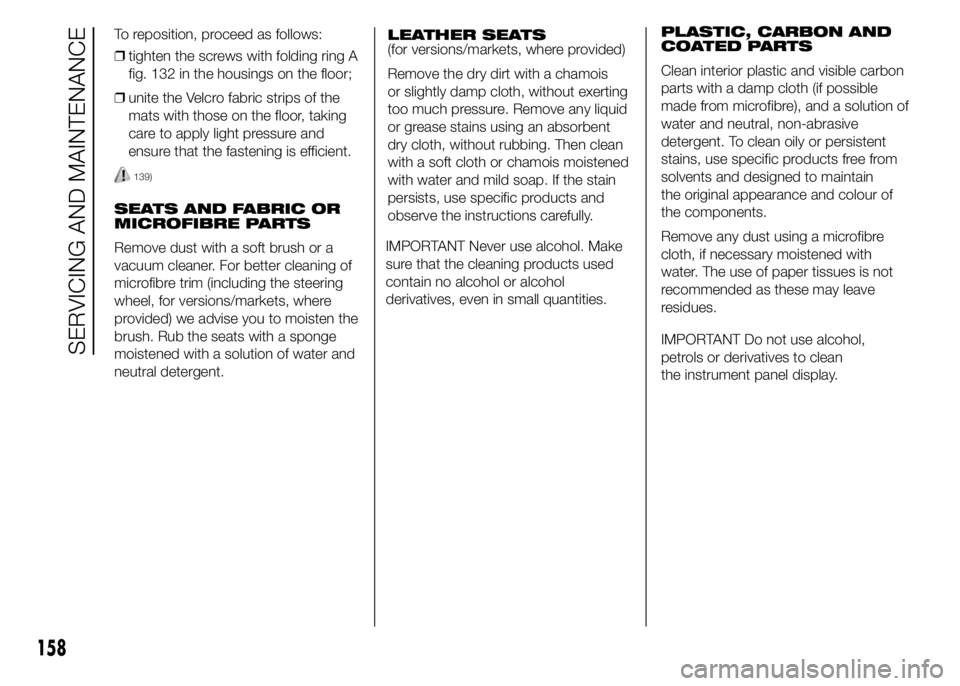
❒tighten the screws with folding ring A
fig. 132 in the housings on the floor;
❒unite the Velcro fabric strips of the
mats with those on the floor, taking
care to apply light pressure and
ensure that the fastening is efficient.
139)
SEATS AND FABRIC OR
MICROFIBRE PARTS
Remove dust with a soft brush or a
vacuum cleaner. For better cleaning of
microfibre trim (including the steering
wheel, for versions/markets, where
provided) we advise you to moisten the
brush. Rub the seats with a sponge
moistened with a solution of water and
neutral detergent.LEATHER SEATS
(for versions/markets, where provided)
Remove the dry dirt with a chamois
or slightly damp cloth, without exerting
too much pressure. Remove any liquid
or grease stains using an absorbent
dry cloth, without rubbing. Then clean
with a soft cloth or chamois moistened
with water and mild soap. If the stain
persists, use specific products and
observe the instructions carefully.
IMPORTANT Never use alcohol. Make
sure that the cleaning products used
contain no alcohol or alcohol
derivatives, even in small quantities.PLASTIC, CARBON AND
COATED PARTS
Clean interior plastic and visible carbon
parts with a damp cloth (if possible
made from microfibre), and a solution of
water and neutral, non-abrasive
detergent. To clean oily or persistent
stains, use specific products free from
solvents and designed to maintain
the original appearance and colour of
the components.
Remove any dust using a microfibre
cloth, if necessary moistened with
water. The use of paper tissues is not
recommended as these may leave
residues.
IMPORTANT Do not use alcohol,
petrols or derivatives to clean
the instrument panel display.
158
SERVICING AND MAINTENANCE
To reposition, proceed as follows:
Page 163 of 199
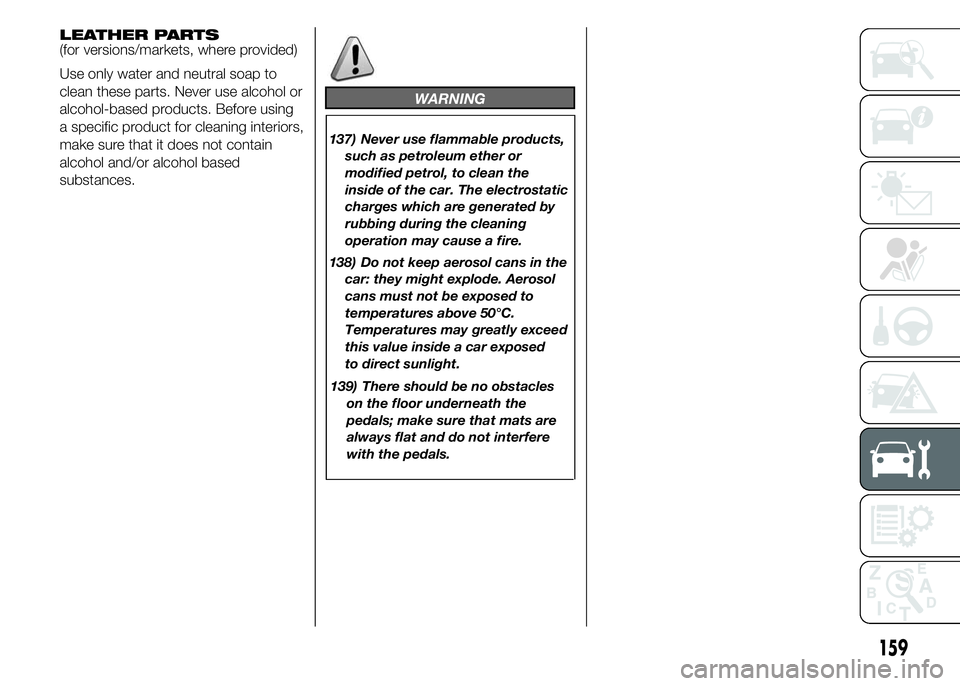
159
WARNING
137) Never use flammable products,
such as petroleum ether or
modified petrol, to clean the
inside of the car. The electrostatic
charges which are generated by
rubbing during the cleaning
operation may cause a fire.
138) Do not keep aerosol cans in the
car: they might explode. Aerosol
cans must not be exposed to
temperatures above 50°C.
Temperatures may greatly exceed
this value inside a car exposed
to direct sunlight.
139) There should be no obstacles
on the floor underneath the
pedals; make sure that mats are
always flat and do not interfere
with the pedals.
LEATHER PARTS
(for versions/markets, where provided)
Use only water and neutral soap to
clean these parts. Never use alcohol or
alcohol-based products. Before using
a specific product for cleaning interiors,
make sure that it does not contain
alcohol and/or alcohol based
substances.
Page 164 of 199
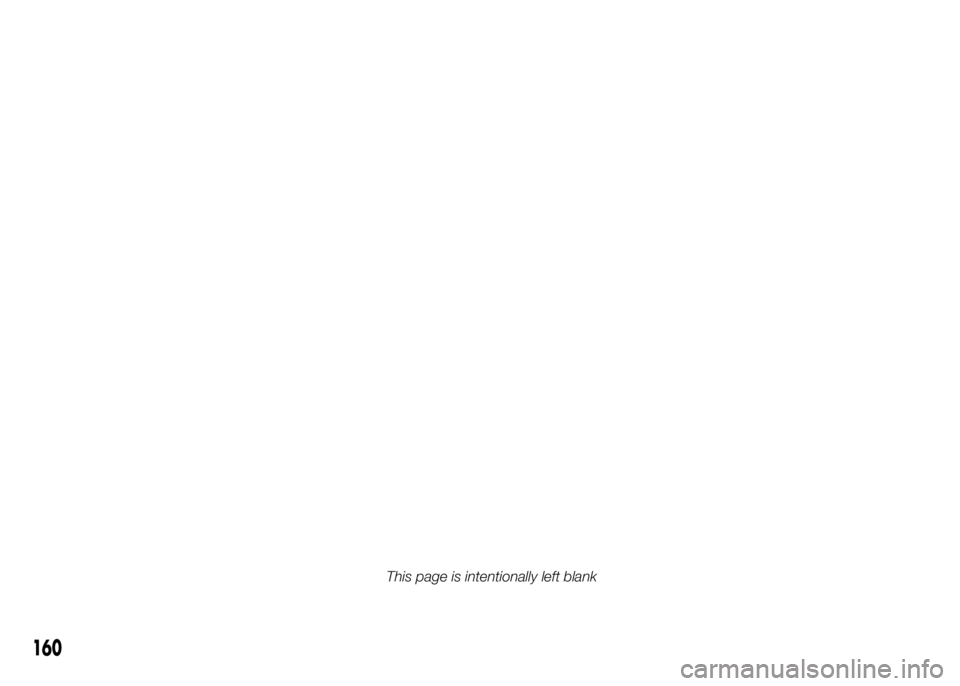
160
This page is intentionally left blank
Page 165 of 199
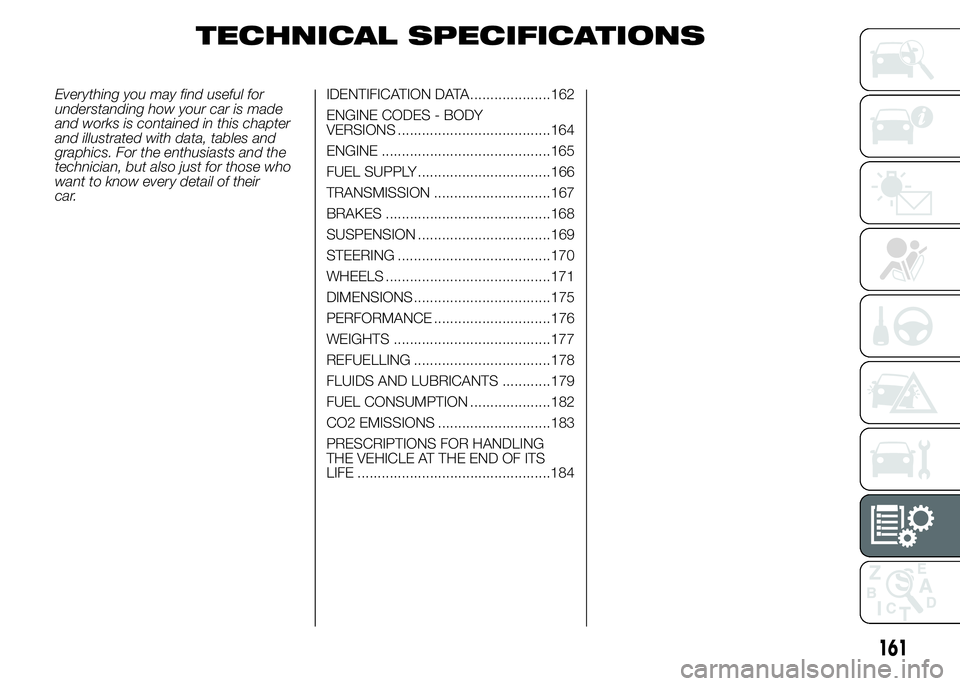
TECHNICAL SPECIFICATIONS
Everything you may find useful for
understanding how your car is made
and works is contained in this chapter
and illustrated with data, tables and
graphics. For the enthusiasts and the
technician, but also just for those who
want to know every detail of their
car.IDENTIFICATION DATA....................162
ENGINE CODES - BODY
VERSIONS ......................................164
ENGINE ..........................................165
FUEL SUPPLY .................................166
TRANSMISSION .............................167
BRAKES .........................................168
SUSPENSION .................................169
STEERING ......................................170
WHEELS .........................................171
DIMENSIONS ..................................175
PERFORMANCE .............................176
WEIGHTS .......................................177
REFUELLING ..................................178
FLUIDS AND LUBRICANTS ............179
FUEL CONSUMPTION ....................182
CO2 EMISSIONS ............................183
PRESCRIPTIONS FOR HANDLING
THE VEHICLE AT THE END OF ITS
LIFE ................................................184
161
Page 166 of 199
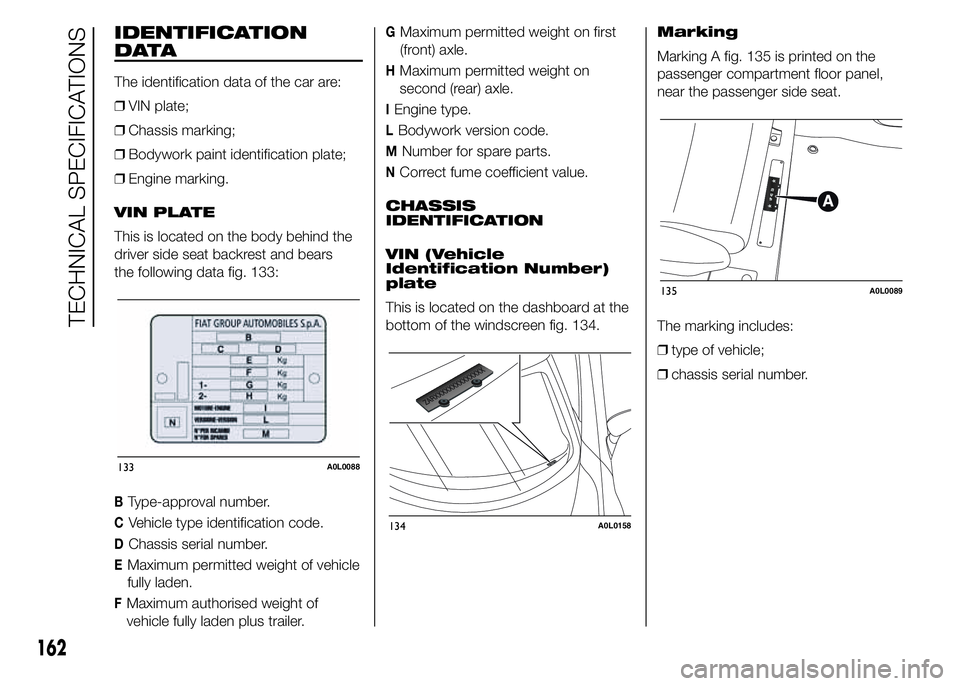
IDENTIFICATION
DATA
The identification data of the car are:
❒VIN plate;
❒Chassis marking;
❒Bodywork paint identification plate;
❒Engine marking.
VIN PLATE
This is located on the body behind the
driver side seat backrest and bears
the following data fig. 133:
BType-approval number.
CVehicle type identification code.
DChassis serial number.
EMaximum permitted weight of vehicle
fully laden.
FMaximum authorised weight of
vehicle fully laden plus trailer.
GMaximum permitted weight on first
(front) axle.
HMaximum permitted weight on
second (rear) axle.
IEngine type.
LBodywork version code.
MNumber for spare parts.
NCorrect fume coefficient value.
CHASSIS
IDENTIFICATION
VIN (Vehicle
Identification Number)
plate
This is located on the dashboard at the
bottom of the windscreen fig. 134.Marking
Marking A fig. 135 is printed on the
passenger compartment floor panel,
near the passenger side seat.
The marking includes:
❒type of vehicle;
❒chassis serial number.
133A0L0088
134A0L0158
135A0L0089
162
TECHNICAL SPECIFICATIONS
Page 167 of 199
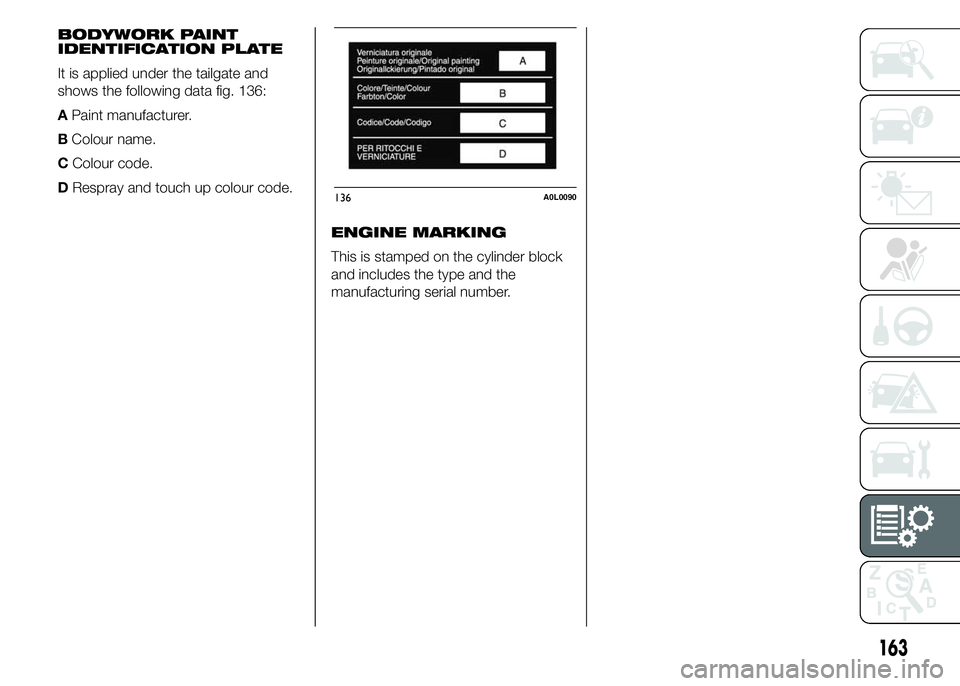
ENGINE MARKING
This is stamped on the cylinder block
and includes the type and the
manufacturing serial number.
136A0L0090
163
BODYWORK PAINT
IDENTIFICATION PLATE
It is applied under the tailgate and
shows the following data fig. 136:
APaint manufacturer.
BColour name.
CColour code.
DRespray and touch up colour code.
Page 168 of 199
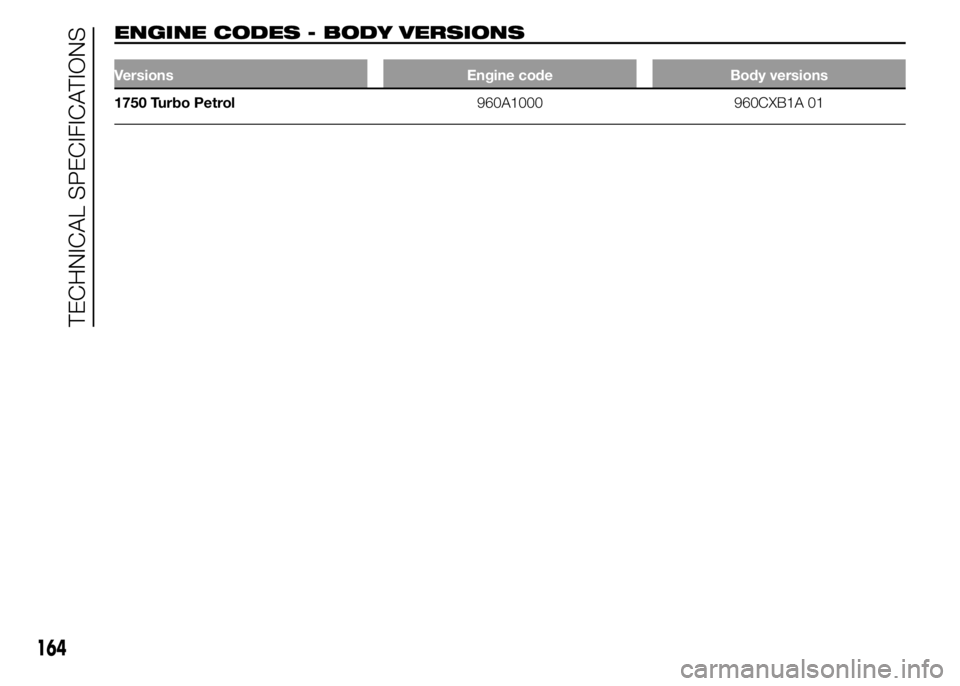
ENGINE CODES - BODY VERSIONS
Versions Engine code Body versions
1750 Turbo Petrol960A1000 960CXB1A 01
164
TECHNICAL SPECIFICATIONS
Page 169 of 199
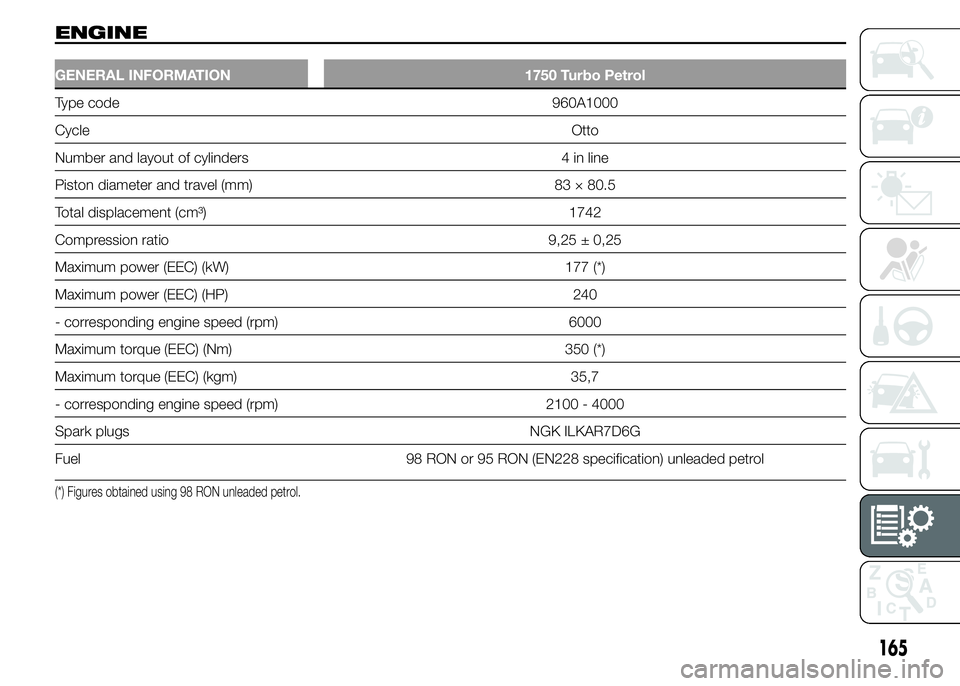
ENGINE
GENERAL INFORMATION 1750 Turbo Petrol
Type code 960A1000
CycleOtto
Number and layout of cylinders 4 in line
Piston diameter and travel (mm) 83 × 80.5
Total displacement (cm³) 1742
Compression ratio 9,25 ± 0,25
Maximum power (EEC) (kW) 177 (*)
Maximum power (EEC) (HP) 240
- corresponding engine speed (rpm) 6000
Maximum torque (EEC) (Nm) 350 (*)
Maximum torque (EEC) (kgm) 35,7
- corresponding engine speed (rpm) 2100 - 4000
Spark plugs NGK ILKAR7D6G
Fuel 98 RON or 95 RON (EN228 specification) unleaded petrol
(*) Figures obtained using 98 RON unleaded petrol.
165
Page 170 of 199
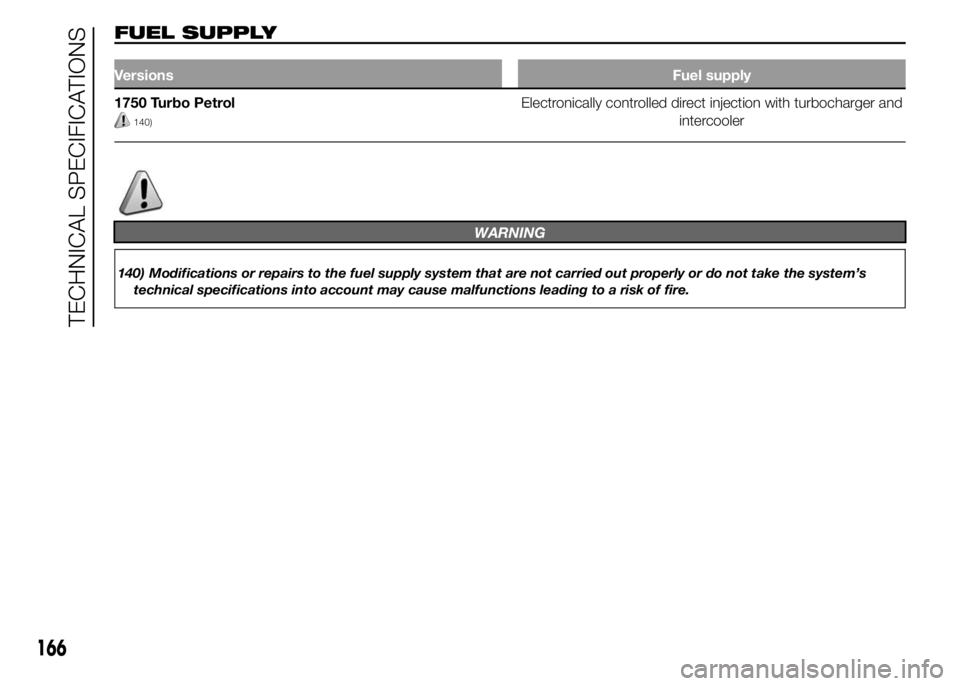
FUEL SUPPLY
VersionsFuel supply
1750 Turbo Petrol
140)
Electronically controlled direct injection with turbocharger and
intercooler
WARNING
140) Modifications or repairs to the fuel supply system that are not carried out properly or do not take the system’s
technical specifications into account may cause malfunctions leading to a risk of fire.
166
TECHNICAL SPECIFICATIONS